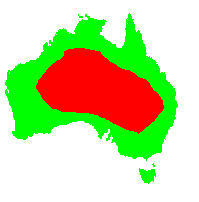General Description:
Eremophila is a large genus of 214 species, all endemic to Australia. They are generally plants of inland and arid areas and are popular with Australian plant enthusiasts.
Eremophila macdonnelii is a variable species and a number of forms are in cultivation. Several prostrate forms exist and other forms may reach 1 metre or more in height. Prostrate forms may spread up to 5 metres but a 1 to 2 metre spread is more common. The foliage is also variable and may be linear to about 25mm or rounded. The leaves are usually silvery grey in colour with dense or sparse hairs.
The purple flowers are large (up to 35mm long) and have a flattened, tubular shape. They occur in winter and spring on long pedicels (flower stalks). The rounded, fleshy fruits are about 15mm in diameter.
E.macdonnellii is a desirable species and grows well in dry climates on a variety of soils which must have good drainage. It is less suitable to sub-tropical and tropical areas where it is often short lived. In those areas the plants need to be located in a sunny area with excellent air circulation as they can be attacked by grey mould (Botrytis) during still, humid conditions. The species will tolerate alkaline soils and full sun is preferred. It is also tolerant of at least moderate frost.
Propagation from seed of Eremophila species is unreliable. A number of treatment methods have been tried including sowing the ripe fruits, sowing of aged and washed fruits and splitting the fruits to extract the seeds prior to sowing. The latter involves splitting the fruits in halves and quarters but some seeds are inevitably damaged during the process.
Most forms of E.macdonnellii strike readily from cuttings of hardened, current season’s growth.

Eremophila macdonnelii
Photo: Brian Walters
Images of all Eremophila species, hybrids and cultivars can be seen in the Eremophila Study Group’s Eremophila Image Database
 Australian Native Plants Society (Australia)
Australian Native Plants Society (Australia)